The Lenovo ThinkPad X1 Carbon Review (2015)
by Brett Howse on May 21, 2015 8:00 AM EST- Posted in
- Laptops
- Lenovo
- ThinkPad
- Ultrabook
- Broadwell-U
Display
Lenovo offers two display choices in the X1 Carbon, with a 1920x1080 model as the base option, and a 2560x1440 available with or without touch. While the resolution of the base panel is fine, the fact that it is a TN panel is not, so I would avoid that if at all possible. Thankfully the step up to the higher resolution model for $150 also gets you an IPS panel. With many devices that I see, there are some questionable decisions made, and I think the TN panel on a $1000+ Ultrabook is the one on this device.
Luckily Lenovo shipped the IPS panel for review. It is a 14-inch panel with a full RGB stripe. In the hardware ID the panel is just labeled as Lenovo, so I can’t say for sure who makes this panel. This model also has the touch digitizer. Despite that, it has almost a matte coating applied to it, or at least the anti-reflective coating is quite effective. This display also came with a built in ICC profile, so it was tested with that ICC being used.
To test the display characteristics, we use SpectraCal's CalMAN 5 suite along with the X-Rite i1Display Pro colorimeter for brightness and contrast readings, and the X-Rite i1Pro spectrophotometer for color accuracy testing.
Brightness and Contrast
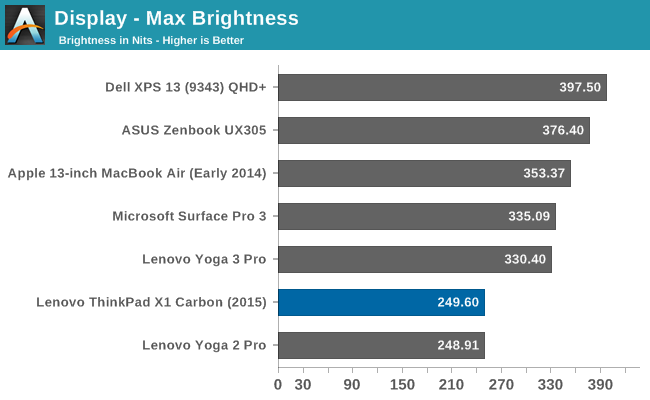
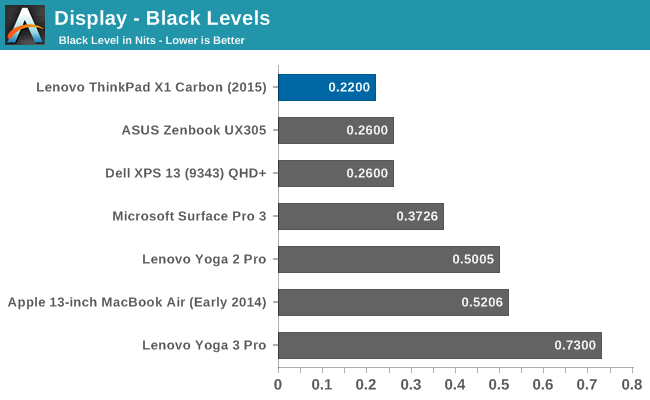
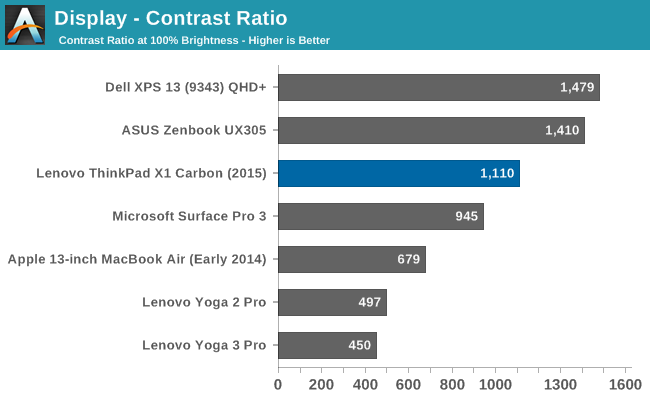
At 250 nits, the X1 Carbon does not get as bright as much of the competition. In fact, to do the color calibration steps, we set the display to 200 nits which is 92% in the power settings of this device. However black levels are quite good, so the overall contrast ratio is still a respectable 1100:1.
Grayscale
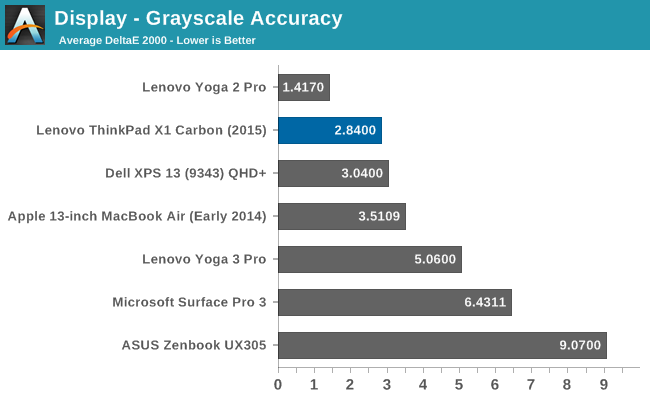
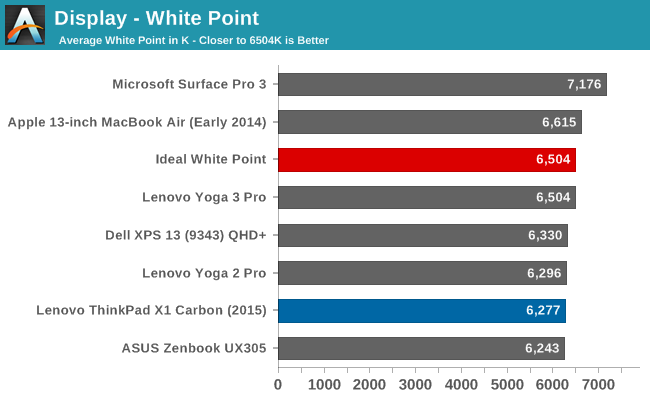
With an average score under three, the grayscale on the X1 Carbon is quite good. The errors do get a bit higher though as the brightness increases, and 100% white actually has a dE of over 5. Gamma drops down quite a bit at the higher brightness levels, and the overall gamma is just 2.0, and the target is 2.2.
Saturation

Saturation accuracy was decent on this display with an overall error level of 3.5, as an average over all of the readings. It is not the best display, but it is far from the worst. It is really the reds that drift off the most.
GMB
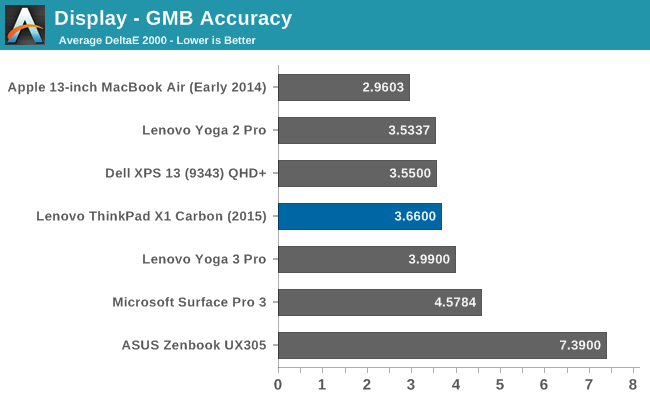
The Gretag Macbeth is the most comprehensive of the tests, and it tests quite a few colors including a lot of the flesh tones. The overall score is once again a good, but not great result, at 3.66.
The overall display is really just average, with no really standout features. The brightness is a bit low, but the contrast is good. Colors are off, but not dramatically. Out of curiosity, I also tested the display without the ICC profile as well, and surprisingly it did not have much of a change in the results. When a generic ICC profile is used, it can’t take into account variability in the individual panels.
Generally ICC profiles are the most help to grayscale, so I ran through our calibration to see how much we could improve the panel.
The grayscale sees a significant improvement, with a dE2000 of just 0.454 and gamma is almost spot on a 2.2. This is what calibration should do, so it was great to see the improvement. Unfortunately this only had a mild effect on the color related scores. Without a 3D LUT, there is only so much you can do.
One other thing that I need to mention about the display is that, at least on the sample I received, there was a bit of a twinkle in the display, which was more noticeable on light colors like white. All displays have a bit of this due to the glue and coatings applied, but on the X1 Carbon it was a bit more noticeable than I was used to.
So overall the display is just OK. Back in 2013 when the X1 Carbon first launched, a display of this quality would have been quite welcomed, but as with all things, progress moves forward and expectations get higher with the competition.

















103 Comments
View All Comments
Chloiber - Monday, May 25, 2015 - link
Sounds to me like a layer 8 issue right there.drwho9437 - Sunday, May 31, 2015 - link
So I have owned a T60, an X200, an X220 and an X230.I sold the T60 to get the X200 because I wanted something smaller. No issues with it until sale. I still have the X200 only failure is a small crack in the bezel that I caused by picking it up pinching the right hand side of the screen for years and years.
I got my mother a T61 which did seem to develop a firmware issue after 2 years (it was already 10 years old; I had gotten it used). I replaced it with a T400 which is working well.
My X220 was working fine when I sold it. It had always run a little hot for my taste so I replaced it with the X230 as I had a chance to use the new style keyboard and found it not completely unacceptable.
Friend of mine has an X201t no issues. I got an X300 off ebay for next to nothing, it does run hotter than I would have thought for so low a power CPU but the fan is tiny. One mouse button didn't work so I got a new set for few dollars.
All in all some failures to be sure but I have yet to have a single failure in year 1, that said I always buy them refurbished from the outlet or used. Perhaps those get more testing. They cost about 75% of new too, with a longer 3 year warranty in most cases. I just wait until what I want shows up on the outlet and then get it. The need for the newest computer available is long over.
carbonx1_is-the-worst - Friday, May 22, 2015 - link
Battery broke completely within 18 months for no apparent reason - one day my laptop simply said 'no battery'. Replacement part order took forever - had to call IBM that handles parts for lenovo. part cost over $160 with shipment; installation cost $50 by geeksquad. Once installed, new battery runtime = 4h which is 50% of IBM-tech-support-promised capacity for the new part which was supopsed to be exactly the same OEM as in the brand new laptop. Now, dealing with faulty part replacement - which is another ordeal -- first you call IBM "supplies" number recommended on the packlist; then IBM send you an email with instruction to forward that email to 'returns' - etc. I think they dropped a ball here - the process could have been much more COMPLICATED so no one ever bothers with replacement requests. For instance, IBM could have gently recommended to write a letter by hand with special golden-sparkle-inc explaining the reasons for exchange order, then pack the letter in the eggshell colored in black, then put the eggshell in the treasure box of size 10x10cm, then put that in the oversized envelop with sufficient amount of cushioning, and at last, courier-deliver that to a special location in PA and give a secret knock on IBM/Lenovo door: knock-knock --- triple knock.protomech - Saturday, May 23, 2015 - link
Wat? You went back to a 2010 laptop over a new 2015 because it offers better battery life?That's.. surprising.
beastly - Sunday, November 29, 2020 - link
I have the X1 Carbon as well and it has easily. 19 hr life and charges in about 40 mins to 100%. The biggest factor for laptops not living up to the estimated battery life generally has to do with USB devices drawing off that battery. I use a powered USB hub to prevent battery drain from slave USB devices.lilmoe - Thursday, May 21, 2015 - link
Really, battery life is a bummer for an otherwise great, expensive machine. But ultrabooks aren't for people like me anyway (also a developer; VS2013/15). I wouldn't mind the extra thickness, performance and weight of the T450s with its hot swappable battery.sorten - Thursday, May 21, 2015 - link
I guess it depends what you're developing. For me personally, performance has always been more important than battery life because my laptop is docked and attached to two monitors for 95% of my dev time. The only time battery life is a concern is when I'm stuck in all day planning sessions. If I'm undocked and programming on the couch or in some open space at the office then I'm concerned with heat and, to a lesser extent, noise.mmrezaie - Thursday, May 21, 2015 - link
I have a decent Xeon workstation and some other clusters. I need something with decent performance that I can take where ever I go and also with best class battery. Something that thinkpad was. Actually some of my colleagues chose x250, but somehow I prefer the macbook pros.mmrezaie - Thursday, May 21, 2015 - link
which is not remotely as durable as I would like. You should have it for a year to see what happens to it.lilmoe - Thursday, May 21, 2015 - link
Having both would be great (and I really love the ability to hot swap batteries). I'm a freelance developer and I have my own LoB software. I use lots of rich controls, so Visual Studio could use all the oomph it can get. WPF can be harsh at design time, even WinForms can with lots of nested table layout panels. I was shopping around last year for a new Haswell MQ/HQ laptop around the time when Lenovo kind of MESSED UP the trackpad among other things.....I don't like U-series CPUs so I opted for a 4702MQ HP ProBook and it's been great. I installed decent quality 16GB RAM modules and a Samsung 850 Pro to help. I'm getting 3-4 hours of heavy usage and, now after Windows 10, up to 8 hours of light use and browsing on Edge (used to be less than 7). But I seriously HATE the TN panel, and I've been shopping around for an IPS replacement part (still waiting on the HP agent in my country) since none of the models I've seen had IPS.
I really LOVE Thinkpads, but Lenovo just has to mess something up. I can live with a not-so-great screen and so-so battery life if performance was great, but a trackpad with no physical buttons and good travel (on the bottom of the pad)?? Heck no. Not even the clicky type buttons. I hope they get those back next gen.
I have my eyes on the T550 since I need the numpad, hope the next gen will have hot swap batteries like the T550s. Anandtech really need to do some comprehensive testing of the T-series, and not only U-series alone.